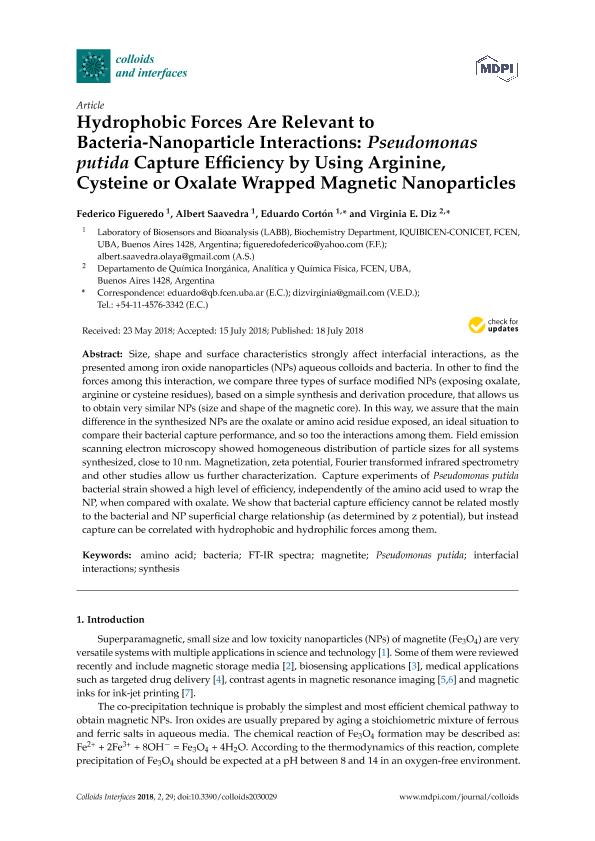Artículo
Hydrophobic Forces Are Relevant to Bacteria-Nanoparticle Interactions: Pseudomonas putida Capture Efficiency by Using Arginine, Cysteine or Oxalate Wrapped Magnetic Nanoparticl
Fecha de publicación:
07/2018
Editorial:
MDPI
Revista:
Colloids and Interfaces
ISSN:
2504-5377
Idioma:
Inglés
Tipo de recurso:
Artículo publicado
Clasificación temática:
Resumen
Size, shape and surface characteristics strongly affect interfacial interactions, as the presented among iron oxide nanoparticles (NPs) aqueous colloids and bacteria. In other to find the forces among this interaction, we compare three types of surface modified NPs (exposing oxalate, arginine or cysteine residues), based on a simple synthesis and derivation procedure, that allows us to obtain very similar NPs (size and shape of the magnetic core). In this way, we assure that the main difference in the synthesized NPs are the oxalate or amino acid residue exposed, an ideal situation to compare their bacterial capture performance, and so too the interactions among them. Field emission scanning electron microscopy showed homogeneous distribution of particle sizes for all systems synthesized, close to 10 nm. Magnetization, zeta potential, Fourier transformed infrared spectrometry and other studies allow us further characterization. Capture experiments of Pseudomonas putida bacterial strain showed a high level of efficiency, independently of the amino acid used to wrap the NP, when compared with oxalate. We show that bacterial capture efficiency cannot be related mostly to the bacterial and NP superficial charge relationship (as determined by z potential), but instead capture can be correlated with hydrophobic and hydrophilic forces among them.
Palabras clave:
AMINO ACID
,
FT-IR SPECTRA
,
INTERFACIAL INTERACTIONS
,
MAGNETITE
Archivos asociados
Licencia
Identificadores
Colecciones
Articulos(ICT - MILSTEIN)
Articulos de INST.DE CS. Y TECNOLOGIA "DR. CESAR MILSTEIN"
Articulos de INST.DE CS. Y TECNOLOGIA "DR. CESAR MILSTEIN"
Articulos(IQUIBICEN)
Articulos de INSTITUTO DE QUIMICA BIOLOGICA DE LA FACULTAD DE CS. EXACTAS Y NATURALES
Articulos de INSTITUTO DE QUIMICA BIOLOGICA DE LA FACULTAD DE CS. EXACTAS Y NATURALES
Citación
Figueredo, Federico; Saavedra Olaya, Albert Ulises; Corton, Eduardo; Diz, Virginia Emilse; Hydrophobic Forces Are Relevant to Bacteria-Nanoparticle Interactions: Pseudomonas putida Capture Efficiency by Using Arginine, Cysteine or Oxalate Wrapped Magnetic Nanoparticl; MDPI; Colloids and Interfaces; 2; 3; 7-2018; 29-45
Compartir
Altmétricas




